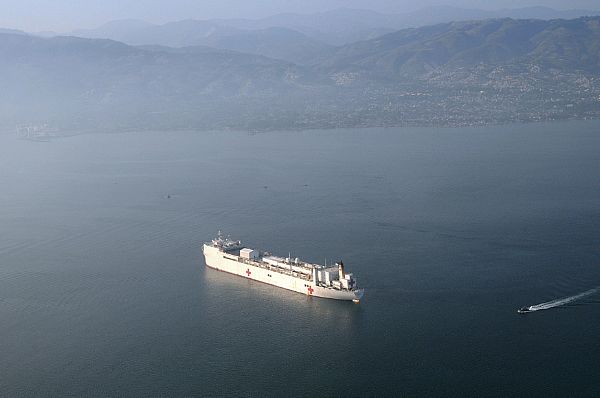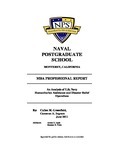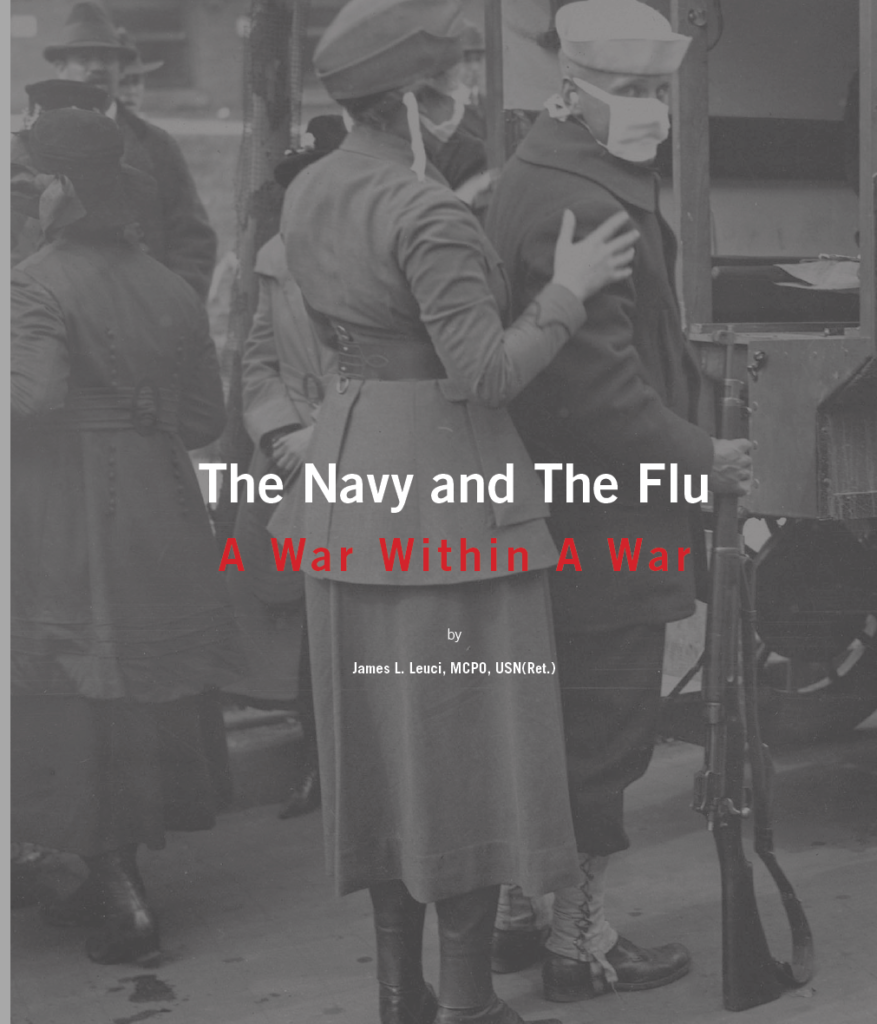
By Rear Admiral Robert Wray, USN (Ret.)
With the recent response to the Coronavirus/COVID19 and the recent deployments of Navy Medical personnel and the USNS Comfort and USNS Mercy to New York City and San Francisco, the Naval Historical Foundation (NHF) asked me to recall the response of the USNS COMFORT to the Haiti earthquake in 2010 for the NHF’s “Thursday Tidings”. The following is a brief and unofficial recollection of the events of that momentous week. The point is that this short notice deployment of medical personnel is not unprecedented and is in the wheelhouse of Navy capabilities for medical emergencies and humanitarian assistance/disaster relief situations that can occur with little to no notice.
At about 5 pm local on Tuesday, 12 January 2010, Haiti was struck by a magnitude 7.0 earthquake, centered just west of the capital of Port-au-Prince. In this nation of 10 million people, approximately 230,000 died. The primary airport was disabled, and the shipping facilities in the primary harbor were demolished. The island was completely cut off.
At the time, I was the Deputy Commander of Military Sealift Command. Among our 180 ships were the two hospital ships, including the USNS COMFORT, berthed in Baltimore. My boss, the MSC Commander, and now Director of the Maritime Administration, RADM Buz Buzby, was at sea on an oiler in the Atlantic, so I was in charge at MSC Headquarters.
VADM Pete Daly at Fleet Forces Command called me at about 4 am on Wednesday the 13th , and told me to get COMFORT underway to support the US effort in Haiti. The hospital ships are kept in ROS 5, which means “reduced operating status, ready to get underway in 5 days.” I told Fleet Forces that we’d start preps immediately, that we’d need 5 days to be ready, and that we could get underway on Monday, the 18th.
Things began to get complicated really fast.
First, the COMFORT was in repair period, meaning that she wasn’t ready to be ready in the normal 5 days. Think of a car in the garage, and a friend has an emergency and needs a ride to get help, but the engine on the car is disassembled and in pieces on the floor. To get underway, we had to finish or cancel the repair package, and then do all the things we’d normally do to get her ready for sea. Remember that while the COMFORT would sail with well over a thousand souls on board, during her ROS status she has a crew of only a couple dozen personnel.
Second, while our standard procedure was to be ready in 5 days—it’s how we train, how we man the ships, how we operate our logistics– five days wasn’t fast enough for America’s effort in Haiti. Senior leadership in the Department of Defense, without consultation suggested that we wouldn’t take 5 days, we’d do it in 4, and we’d depart Sunday. Another senior leader suggested the Comfort could deploy in less than five days—again—without consultation with anyone at the Military Sealift Command. Our organization was now in overdrive developing courses of action to meet what essentially was a three-day requirement to get Comfort underway and headed to Haiti.
Third, the hospital ships typically get underway in 5 days and steam to some forward location, at which the medical staffs are assembled. That gives them a few extra days to get all their people and gear and supplies and drugs. In this case however, the decision was made that everyone—the mission team, the crew, the medical staffs, the force protection folks, the civilian organizations—over 100 different organizations totaling over 1000 people—would leave together on Saturday morning, a mere 72 hours after the initial callup. This had never been done before, ever.
We began pulling out all the stops and breaking all the established rules to get the mission launched by Saturday morning. We had a five-word mission statement: “Underway Saturday Morning Help Haiti.” When any of the 100-plus organizations would call me and ask for help, or direction, or complain that it couldn’t be done, I’d recite the mission statement to them and tell them to do what they needed to, and that I’d authorize it and take the heat for whatever procedures they had to invent or violate to get it done. It was a classic team of teams—no one was in charge of everything—all we could do was to establish the mission and the timetable and encourage individual components to do what they had to do.
We set up military aircraft flying continuous shuttles between Norfolk and Baltimore so we could hurl dozens and dozens of skilled repair personnel to accelerate putting the ship back together. I worked with RADM Matt Nathan, who was CO at Walter Reed Bethesda, to speed up the medical response, to do in 3 days what they were used to doing in 9. I remember telling him I was sending a truck over, and I wanted him to load it full of supplies and drugs. His staff asked, “what supplies and drugs do we need?” and my typical Surface Warfare Officer response was, “Beats me– whatever you need for an earthquake response—just fill the truck.”
On Friday afternoon it looked like we just might make it. We were in one of our thrice-daily command brief and decision sessions when the bombshell hit. The staff said, “Sir, do you want the good news or the bad news first?” I asked for the good news. They said, “The good news is that no one was killed in the explosion.” They continued, “The bad news is that the explosion took out the ships service electrical generator which provides power to the hospital portion of the ship.” Immediate consultation with the staff confirmed (a) that there was no way to cross-power the hospital from another turbo-generator in the next 18 hours (the backup generator was already out of commission), and (b) that sending the hospital ship with no power would be fruitless.
The next few hours were a blur. Eventually, we decided to hire, or rent, a huge generator, about the size of a mobile home, and to lift it onto the top of the ship, and to find a way to wire it into the ship’s electrical distribution system. Oh, and we had to (a) find such a generator, (b) figure out how to get it onto the ship, (c) do the naval architecture calculations to ensure it wouldn’t cause the ship to tip over, (d) do all the contracting and purchasing required, (e) find the human expertise to make the hookup, and (f) about a hundred other details associated with doing what had never been done before. All in the next 18 hours. I was up late Friday night, and early on Saturday morning drove to the ship with our Command Master Chief, Kenny Greene. We were in our Service Dress Blues because we were to be interviewed by Good Morning America and the press there on the pier.
When we arrived, people and equipment were marching in a steady stream up the brow and onto the ship. It was like Noah’s ark. News helicopters were circling overhead. The huge generator had just been landed on the upper deck. I sent the Master Chief to talk to the reporters and I went topside to supervise the generator being welded to the deck – I had visions of the damn generator rolling off the top of the ship when it hit the first swells at the mouth of the Chesapeake.
USNS Comfort got underway, just about on time. Hundreds stood on the pier and waved as she slowly steamed out of Baltimore harbor and out into the Bay. The hundreds who had boarded in the previous 12 hours would self-organize, introduce each other, find racks, stow their gear, get ready to perform the mission. As she sailed, we still had no power to the hospital, but on the ride south, the crew would patch the generator into the ship’s service distribution system, so the hospital had full power by the time she reached the Caribbean. Before the ship was even within sight of Haiti, helicopters began delivering critically wounded victims from the earthquake. The COMFORT crew saved hundreds of lives in the following weeks and became a symbol of America’s humanitarian support in the crisis.
It was a classic example of (a) exactly why we have hospital ships, (b) the power of a simple unambiguous mission statement, and (c) the ingenuity and can-do attitude of our US personnel in response to a necessary mission.

“An Analysis of U.S. Navy Humanitarian Assistance and Disaster Relief Operations”
By Cullen M. Greenfield and Cameron A. Ingram
Below is an excerpt from a thesis analyzing Navy humanitarian relief efforts and recommendations for improvement. Full thesis may be accessed here:
calhoun.nps.edu/bitstream/handle/10945/10769/11Jun_Greenfield_MBA.pdf?sequence=1&isAllowed=y
The Department of Defense (DoD) has been involved in disaster response in the past, but now it has decided to take a leading role in disaster response efforts throughout the globe and, as a result, has become a leader in initial response efforts. As a major component of the DoD, the U.S. Navy (USN) has assumed a large portion of the responsibility. Through the use of surface ships, the DoD can quickly deploy high quantities of relief aid to affected areas in a matter of weeks. The supply line power that the USN possesses is essential in reducing the postdisaster turmoil and easing the ―gap of pain. The gap of pain refers to the time period between when domestic relief efforts are exhausted and when outside relief efforts arrive. The goal for the DoD, and specifically the USN, is to at least reduce, if not close, this gap of pain by having ready ships on standby in nearby areas. The USN refers to its relief operations as humanitarian assistance and disaster relief (HADR) operations.
A growing interest in HADR efforts from Secretary of Defense Robert Gates (2010) and Chairman of the Joint Chiefs of Staff (CJCS) Admiral Mike Mullen (2007) calls for an in-depth analysis of past disaster relief efforts to improve future relief efforts. Admiral Mullen (2011) recently directed military leadership to focus on developing response capabilities to handle problems created by increasing populations in coastal areas and the weak abilities of Third World countries to respond to natural disasters. As part of a U.S. collaboration to exercise control over the high seas, the USN, the U.S. Marine Corps (USMC), and the U.S. Coast Guard (USCG) have joined efforts to support a variety of missions to include humanitarian assistance and disaster relief. The DoD‘s recognition of the importance of maritime efforts in HADR operations is evidenced in the following statement by Admiral Arleigh Burke, USN, (15th CNO):
For in this modern world, the instruments of warfare are not solely for waging war. Far more importantly, they are the means for controlling peace. Naval officers must therefore understand not only how to fight a war, but how to use the tremendous power which they operate to sustain a world of liberty and justice, without unleashing the powerful instruments of destruction and chaos that they have at their command.
HADR operations have become the leading other than war (OTW) mission executed by the USN. Over the past decade, the USN has been essential in the relief efforts of the Haitian earthquake, the Indonesian tsunami, and Hurricane Katrina, to name a few. Its involvement has helped provide millions of tons of medical supplies and food, gallons of fresh water, and personnel to assist those affected by the disasters. While these examples can be viewed as a success, there have been instances where the Navy could have performed better.
On November 15, 2007, Bangledesh was ravaged by Cyclone Sidr, the equivalent to a Category 5 hurricane, which caused over 10,000 deaths and over $450 million in damages. In response, the USN decided to send one of its Guided Missile Destroyers (DDG), which was in the vicinity and on which one of this study‘s authors, LT Ingram, served. The problem the DDG had was its inability to get within close range of Bangledesh. Due to draft constraint and the gradual slope of the Bangledesh coastline, the DDG could approach no closer than 25 miles from the shoreline, out of visible range. In addition to the distance restrictions, the DDG was not outfitted with a helicopter; it could not produce enough water to supply victims or hospitals ashore; it did not have excess food or medical supplies to provide; and, ultimately, it had no way of assisting the devastated country. It was not until two days later, when a Landing Amphibious Assault Ship (LHA) arrived on station, that the USN could provide HADR support.
Combatant commanders (CCDRs) are required to juggle time, space, and force considerations to execute all missions, and the uncertainty of the environment and requirements of HADR operations only increases the complexity of the planning and response process (Preston, 2010). As illustrated in the previous paragraph, the USN often has been very responsive in an effort to provide HADR support; however, there are several lessons learned and improvements that can be made to the process. In the future, the USN plans on becoming more involved in HADR operations, according to Bruce A. Elleman, a naval historian:
‘During the nineteenth and most of the twentieth centuries, the very thought that sea powers might regularly use naval platforms to deliver humanitarian aid, as opposed to cutting off and starving an enemy‘s supply lines, would have seemed alien. In the twenty-first century, however, national power and prestige are more and more characterized by soft power. UNIFIED ASSISTANCE showed that hard power‘ assets like aircraft carriers can also be the best providers of soft power.‘
To become more effective in HADR operations, the USN will need to understand what asset will be best in responding to specific disasters. The assumption that the closest asset is best will not lead to a suitable or effective utilization of resources. There must be a systematic approach to the method in which assets are deployed in support of the HADR mission. The USN is a global leader in disaster relief efforts, particularly because it owns multiple assets that have several capabilities that are unique and extremely useful in relief efforts. Beyond asset capability, the validity of the mission helps to solidify existing partnerships with key nations and open access to new relationships between and among nations, non-governmental organizations, and international organizations‖ (Stavridis, 2010).
The largest benefit that the USN provides is the ability to traverse the sea. With a large number of the world‘s population living in close proximity to the coastline, the USN has the ability to access these areas better than any other service or agency. The size and funding of the USN makes it the leading U.S. organization to take on disaster relief efforts. HADR is a dynamic and unpredictable mission that the USN conducts, which poses a large scale of difficulty.
Read the full thesis here: calhoun.nps.edu/handle/10945/10769


